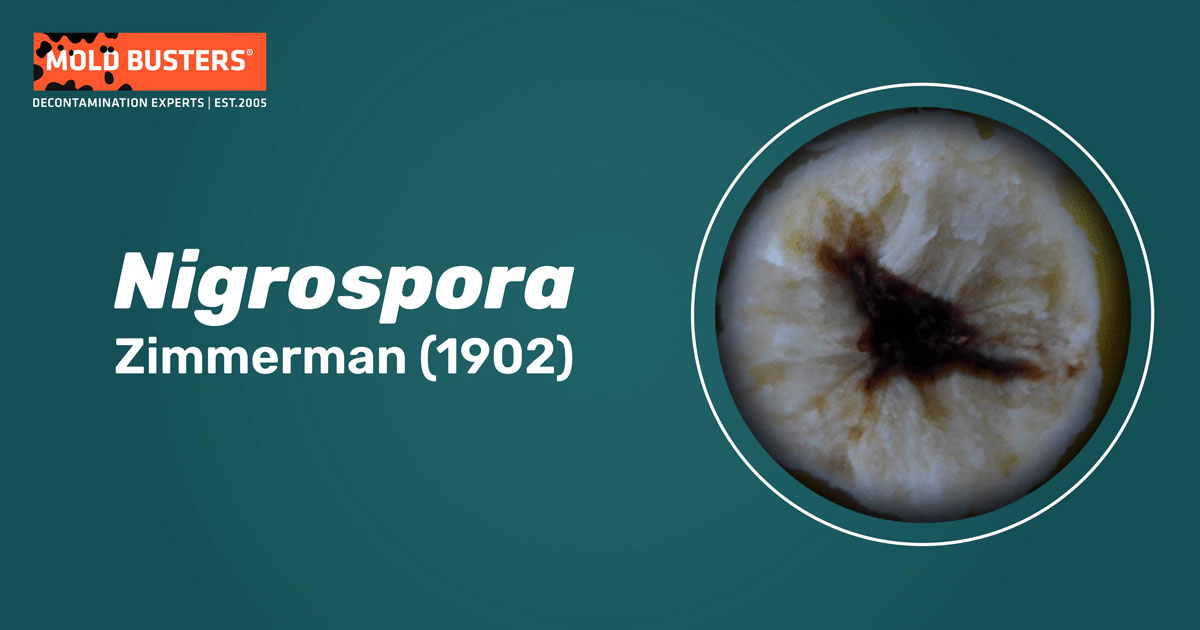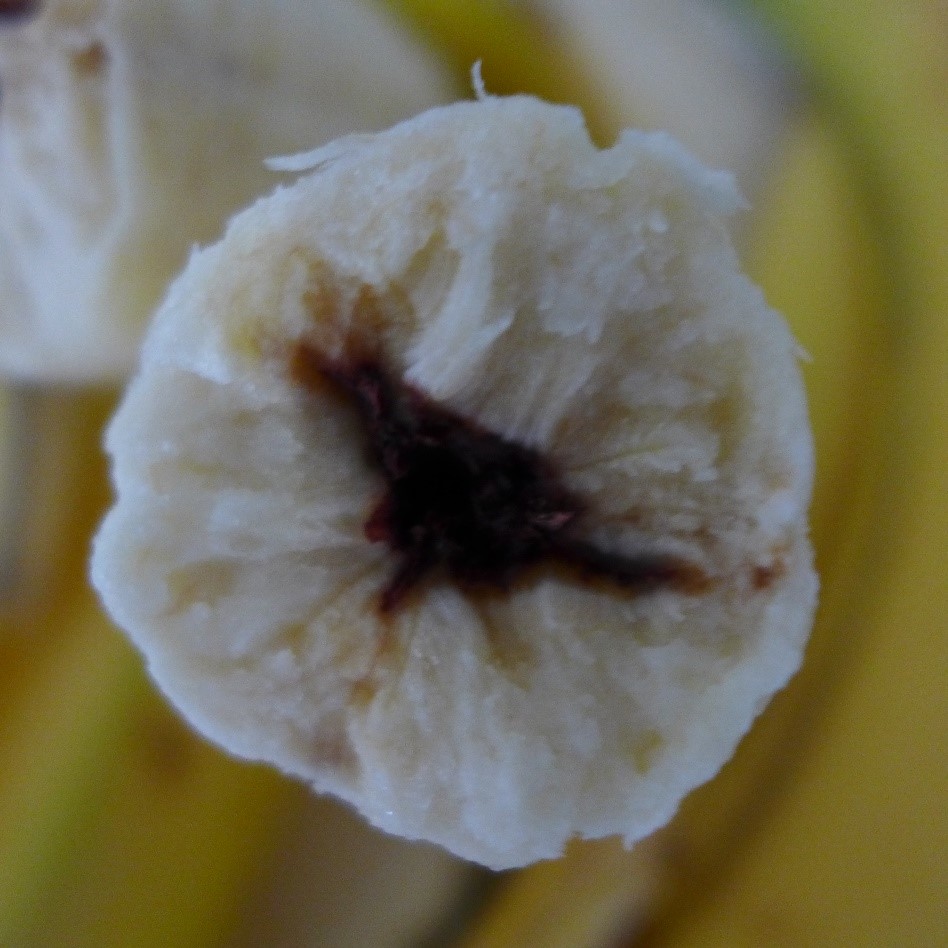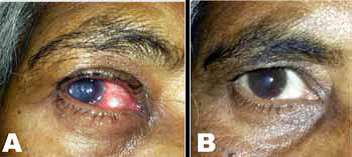Zimmerman (1902)
What is Nigrospora mold?
The genus Nigrospora belongs to the phylum Ascomycota and is comprised of typically dark-spored asexual, filamentous fungi (dematiaceous fungi). The sexual stage of Nigrospora species belongs to the genus Khuskia [1].

Nigrospora species are cosmopolitan, having been isolated from soil, seeds, and organic debris, as well as from a wide range of plant species. Nigrispora fungi are associated with economically important crops such as rice, fruits, and ornamentals as plant endophytes (living in plants without causing infections) or as plant pathogens [1, 2, 3].
What does Nigrospora look like?
Nigrospora species produce glass-like, septate hyphae that become darkly pigmented with age. Asexual spores (conidia) develop at the tips of translucent conidiophores that rise at a 90° angle to the vegetative hyphae. Conidia are single-celled, smooth, spherical to ovoid, and 14–20 µm in diameter. Because of melanin production in cell walls, their color ranges from dark brown to black, Fig. 1 (f-h) [1, 4].
When cultivated, Nigrospora spp. grow rapidly, producing woolly colonies on potato dextrose agar (PDA) at 25 °C (77 °F). Colonies are initially white, becoming gray with black areas when mature, within four days. Depending on isolates, sporulation may take more than three weeks [4].
How many Nigrospora species exist?
The genus Nigrospora contains twenty-seven species [3]. The most important are plant pathogens N. oryzae, N. sphaerica, and N. musae, which cause stem blight disease on a variety of plant hosts, including rice, brown mustard, and tea plants in China. N. oryzae is also a causative agent of ear rot and comb rot of maize, while N. sphaerica is famous for causing the squirter disease on bananas [3, 7]. N. sphaerica is also considered an opportunistic pathogen in humans, causing nail infections and ulcerative lesions of the eyes and skin [2]. In tropical regions, Nigrospora species make up a large proportion of the air spora [5].
Nigrospora pathogens of banana plants
N. sphaerica, as well as N. oryzae, N. sachari, and N. musae, are known for causing squirter disease – on banana plants. This disease is present in tropical countries where banana plants are usually grown, mainly in Australia, Jamaica, and Nigeria [6, 7]. Nigrospora squirter disease resides on banana debris, requires moisture, and sporulates after rainfall or after tree irrigation, and during the transportation and ripening, the disease develops further [7]. The symptoms initially begin by the formation of a dark core or a broken line of dark-red rubbery material along the center core of the banana fruit or near its end (Fig. 1). When light pressure is applied, the pulp transforms into a mushy liquid that squirts out from the base [6]. There are no reports suggesting the harmful effect of eating bananas infected by Nigrospora spp.

What are the adverse health effects of Nigrospora?
Although Nigrospora species are widespread in the environment, they are rarely encountered as human pathogens. Only several cases of human infections caused by Nigrospora species have been reported so far, referring to respiratory allergic reactions as well as skin, nail, and eye infections [8, 9].
Immunocompetent people can also be affected by Nigrospora infection after a traumatic inoculation of the spores. In one such case, a healthy female in India developed an eye infection and a corneal ulcer after an injury caused by a cow’s tail containing soil and plant matter contaminated with spores of Nigrospora. Symptoms included swelling, redness, and vision problems (Fig. 3). The patient was managed medically and fully recovered after the therapy [8].
Another case described refers to an immunocompromised HIV-positive patient who developed multiple skin lesions on his face, scalp, limbs, and trunk. Laboratory analysis confirmed that lesions were primarily caused by N. spherica and secondary infections were caused by a resistant Staphylococcus aureus strain. The patient responded well to both antifungal and antibacterial therapy [9]. Both the described cases refer to tropical countries (India and Africa), where Nigrospora spores are more abundant in the environment.

How to treat Nigrospora?
Since Nigrospora is mainly a plant pathogen that rarely causes opportunistic infections in humans, data on treating drugs is scarce. According to the reports [8, 9], Nigrospora infections can be successfully treated by voriconazole, itraconazole, and ketoconazole. Regarding plant infections, the application of fungicides containing benzimidazole compounds, thiabendazole, and benomyl have shown good results in controlling N. sphaerica [10].

Did you know?
Offices in Canada are the most affected by the Basidiospores mold group?! Find out more exciting mold stats and facts on our mold statistics page.
References
- Nigrospora Retreated from: www.drfungus.org
- Hao, J. et al. (2020). Nigrospora Species Associated with Various Hosts from Shandong Peninsula, China. Mycobiology. 48 (3): 169-183
- Wang, M. et al. (2017). Phylogenetic reassessment of Nigrospora: Ubiquitous endophytes, plant and human pathogens
- Mc Ginnis, M. R. (1980). Laboratory Handbook of Medical Mycology. Academic Press INC. New York. pp. 241-242.
- Manoharachary, C. et al. (2016). Mycology and microbiology. Scientific Publishers, India. pp. 345.
- Squirter disease. Nigrospora musae. Retreated freom: www.agrobaseapp.com
- Meredith, D. S. (1961). Atmospheric Content of Nigrospora Spores in Jamaican Banana Plantations. Journal of General Microbiology. 26: 343-349
- Ananya, T. S. et al. (2014). Nigrospora sphaerica causing corneal ulcer in an immunocompetent woman: A case report. International Journal of Case Reports and Images. 5(10):675–679
- Motswaledi, H. M. et al. (2018). An unusual deep fungal infection with Nigrospora sphaerica in HIV positive patient. International Journal of Dermatology. 58(3):333-335
- Allen, R. N. (1970). Control of black-end and squirter diseases in bananas with benzunidazole and salicylanilide compounds. Australian Journal of Experimental Agriculture and Animal Husbandry. 10: 490-492

Get Special Gift: Industry-Standard Mold Removal Guidelines
Download the industry-standard guidelines that Mold Busters use in their own mold removal services, including news, tips and special offers:

Written by:
Jelena Somborski
Mycologist
Mold Busters
Edited by:
Dusan Sadikovic
Mycologist – MSc, PhD
Mold Busters
